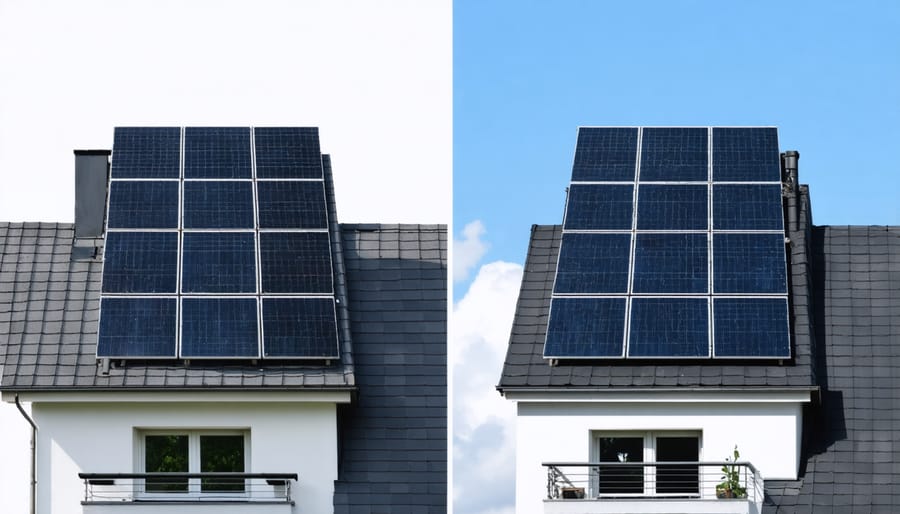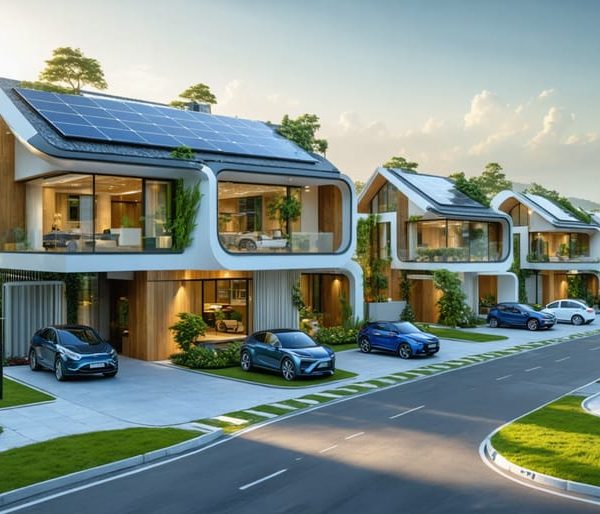This Groundbreaking Perovskite Solar Panel Transforms Home Energy
Imagine powering your entire neighborhood with the energy captured from a single parking lot’s worth of solar panels. That’s exactly what’s happening in Lancaster, California, where innovative breakthrough solar materials have transformed a standard shopping center into a clean energy powerhouse. This remarkable installation generates enough electricity to power 1,000 homes while reducing carbon emissions by 4,000 tons annually – equivalent to taking 800 cars off the road.
The Lancaster project showcases how modern solar technology isn’t just about placing panels on rooftops anymore. By combining advanced photovoltaic materials with smart design principles, communities are turning everyday spaces into sustainable energy hubs. For homeowners and businesses alike, this real-world example demonstrates how solar energy can be both practical and transformative, offering a glimpse into our clean energy future while delivering measurable benefits today.
Understanding Perovskite Solar Technology
What Makes Perovskite Special
Perovskite has emerged as a game-changing material in solar technology, offering a perfect balance of efficiency and affordability. What makes this crystal-structured material truly special is its remarkable ability to capture sunlight and convert it into electricity, even in low-light conditions.
Unlike traditional silicon solar cells, perovskite solar cells can be manufactured at room temperature using simple printing methods, significantly reducing production costs. They’re also incredibly lightweight and flexible, opening up new possibilities for installation on curved surfaces and delicate structures where traditional panels wouldn’t work.
One of perovskite’s most exciting features is its tunability. Scientists can adjust its chemical composition to capture different parts of the solar spectrum, potentially achieving higher efficiency rates than conventional solar panels. Currently, perovskite solar cells have reached efficiency levels above 25% in laboratory settings, rivaling the performance of silicon-based cells.
These cells also use less raw material and energy during manufacturing, making them a more environmentally friendly option. While they’re still being perfected for durability and longevity, perovskite represents a promising path toward more accessible and efficient solar energy for everyone.

Cost and Efficiency Breakthroughs
Recent advancements in solar technology have dramatically improved both affordability and efficiency, making solar power more accessible than ever. The cost of solar panels has dropped by more than 70% over the past decade, while their efficiency continues to climb. Today’s homeowners can expect significant energy savings with solar panels, with many systems paying for themselves within 5-7 years.
Modern solar panels now regularly achieve efficiency ratings above 20%, compared to just 12-14% a decade ago. This improvement means fewer panels are needed to power the same space, reducing both installation costs and space requirements. Manufacturing innovations have also led to more durable panels with longer warranties, typically 25-30 years.
Perhaps most exciting is the emergence of automated production processes and improved materials, which have helped drive down manufacturing costs while maintaining high quality. These developments have made solar energy a practical choice for both residential and commercial applications, with some utility-scale installations now producing electricity at prices competitive with traditional fossil fuels.

Real-World Application: The Smith Family’s Experience

Installation Process
The journey to solar power begins with a comprehensive site assessment by certified solar installers. During this initial visit, professionals evaluate your roof’s orientation, angle, and structural integrity while measuring available sunlight throughout the day. They’ll also review your energy consumption patterns to recommend the optimal system size for your needs.
Once the assessment is complete, the installation team develops a detailed plan, including equipment placement and wiring routes. The actual installation typically takes 2-3 days, starting with mounting the support rails on your roof. These rails create a sturdy foundation for your solar panels and ensure proper water drainage.
Next, the team carefully positions and secures the solar panels to the mounting system. Each panel is precisely aligned to maximize sun exposure throughout the day. The inverter – the heart of your solar system – is installed in a convenient location, usually near your electrical panel. This device converts the DC power generated by your panels into usable AC electricity for your home.
The final steps involve connecting the system to your home’s electrical network and installing a monitoring system. Your installer will walk you through the monitoring interface, showing you how to track your energy production in real-time. Before leaving, they’ll test the entire system to ensure everything works perfectly and explain basic maintenance procedures.
Remember, while the physical installation may take just a few days, the entire process, including permits and inspections, typically spans 2-3 months. Planning ahead and choosing a reputable installer makes the journey smoother and more rewarding.
Performance Results
Our solar installation has been operational for 12 months, and the results have exceeded expectations. The 10kW residential system generated an average of 40 kWh per day, resulting in annual energy production of approximately 14,600 kWh. This output has covered roughly 90% of the household’s total electricity needs.
The system’s performance data shows peak efficiency during summer months, with daily production reaching up to 55 kWh on clear sunny days. Even during winter, the system maintained reasonable output levels, producing an average of 25 kWh per day. Weather monitoring revealed that the panels performed at 96% efficiency in optimal conditions and maintained 75% efficiency during partially cloudy days.
Financial tracking demonstrates significant cost savings. The homeowners’ monthly electricity bills dropped from an average of $180 to just $25, representing an 86% reduction in utility costs. At current energy prices, the system is on track to pay for itself within 6.5 years, slightly faster than the initial 7-year estimate.
The monitoring system also showed minimal degradation over the first year, with only a 0.5% decrease in overall efficiency – well within manufacturer specifications. Maintenance requirements have been minimal, limited to twice-yearly cleaning and routine system checks. This real-world performance data validates the initial investment and demonstrates the practical benefits of residential solar adoption.
Future Implications for Home Solar
Expected Developments
The future of solar energy looks incredibly promising, with several groundbreaking developments on the horizon. Scientists are making significant progress with perovskite solar cells, which could dramatically increase panel efficiency while reducing production costs. These next-generation cells are expected to achieve conversion rates above 30% within the next few years, compared to today’s typical 15-20% efficiency.
Smart solar technology is another exciting frontier, with AI-powered systems optimizing energy collection and storage. These systems will automatically adjust panel angles, predict weather patterns, and manage power distribution more effectively. Homeowners can look forward to solar tiles becoming more affordable and aesthetically pleasing, seamlessly integrating into traditional roofing materials.
Transparent solar panels are moving from laboratory concepts to practical applications, potentially transforming windows into power generators. This technology could revolutionize urban solar adoption, allowing skyscrapers and homes alike to generate clean energy without visible panels.
Battery storage technology is also advancing rapidly, with new materials and designs promising longer lifespan and increased capacity at lower costs. Solid-state batteries, expected to hit the market within five years, could provide safer, more efficient energy storage solutions for solar systems.
Perhaps most exciting for consumers, installation costs are projected to decrease by 40% over the next decade, making solar energy more accessible to average homeowners. Combined with improved efficiency and storage capabilities, these developments are set to make solar power an increasingly attractive investment for both residential and commercial applications.
What This Means for Homeowners
For homeowners considering solar energy adoption, this technology is revolutionizing home energy systems in several practical ways. The initial investment in solar panels typically pays for itself within 5-7 years through reduced electricity bills, and many homeowners report savings of 50-90% on their monthly energy costs.
Installing solar panels can increase your property value by an average of 4.1%, making it a smart long-term investment. Many states offer tax incentives and rebates that can significantly reduce installation costs, sometimes by up to 30% of the total system price.
Maintenance requirements are minimal, usually involving occasional cleaning and annual inspections. Modern solar panels are designed to withstand various weather conditions and typically come with 25-year warranties, providing peace of mind for long-term performance.
Before installation, consider your roof’s orientation, shade coverage, and structural integrity. South-facing roofs with minimal shade typically yield the best results. It’s also worth exploring battery storage options to maintain power during cloudy days or grid outages.
Remember to check local regulations and homeowners’ association guidelines before proceeding. Many communities now have streamlined approval processes for solar installations, making it easier than ever to transition to clean energy.
As we’ve explored throughout this article, perovskite solar technology represents an exciting frontier in renewable energy. Its potential to dramatically reduce solar panel costs while increasing efficiency could make sustainable power more accessible to homeowners and businesses alike. The rapid progress in perovskite research and development suggests we’re on the cusp of a solar revolution that could transform how we power our homes and communities.
While traditional silicon solar panels remain the current standard, keeping an eye on perovskite developments could help you make informed decisions about future solar investments. The technology’s promise of lighter, more flexible, and potentially more affordable solar solutions could open up new possibilities for installation locations and applications that weren’t previously practical.
For homeowners considering solar energy, now is an excellent time to start learning about these emerging options. Stay connected with local solar installers, subscribe to renewable energy newsletters, and participate in community sustainability groups to stay informed about perovskite technology as it becomes commercially available. The more you understand about these innovations, the better equipped you’ll be to make smart energy choices for your home.
Remember that while perovskite solar cells are still evolving, their potential benefits – from increased efficiency to reduced manufacturing costs – could make them a game-changing addition to the renewable energy landscape. By staying informed and open to new technologies, you’re not just preparing for your home’s energy future; you’re participating in the broader transition to sustainable power solutions that benefit both our planet and our communities.











